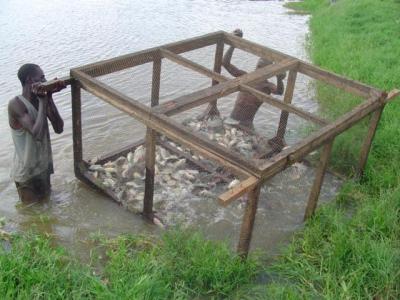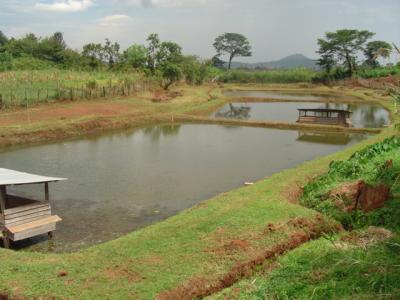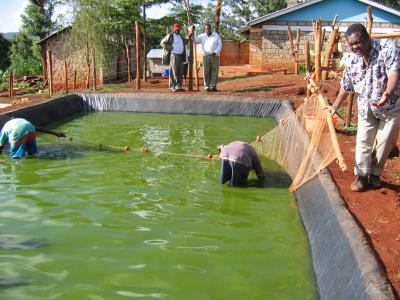Credits: Biovision-Infonet
Production techniques
When planning for commercial aquaculture, the following aspects of production must be considered very critically:
i. Species to be produced
ii. Production site
iii. Production technology
I. Species to be produced
The choice of what to produce will be guided by:
a) Market preference
b) Ecological requirements of the species
c) Production technology of the species
d) Resources available to produce
The species to be produced must not only be marketable but also suited for the climate and be produced cost effectively. Different species require different climatic conditions to perform optimally. For example:
- Nile tilapia and African catfish require warm water of more than 25degC to achieve high growth potential. Growth of these fish is quite slow at elevations greater than 1600 meters because the water temperatures are very low. For best performance, average water temperatures of about 28degC are best. In Kenya, such regions are to be found in low land areas. In areas where temperatures are lower, a larger pond surface area can compensate for that. High sunlight intensity is also preferred for tilapia culture under semi-intensive production.
- Trout require cold, fast flowing clean water of less than 18degC for growing out and below 10degC for hatchery production. Such conditions in Kenya are to be found in high altitudes areas.
It is also important to know
whether the species selected for production is adaptable to intended
culture conditions and there is adequate knowledge of the reproductive
biology, nutritional requirements, common diseases and parasites of the
species. Also important is to ascertain that the species proposed for
production is being profitably produced at commercial levels by other
producers.
Other issues to consider, which are equally important are:
- Is there a reliable supply of good quality juveniles at a reasonable price, for stocking?
- Are you capable of establishing your own seeds (juveniles or ova) production capacity?
- Is there quality feed for the species and are the prices cost effective?
- Do you have a reliable and affordable source for specialized production supplies and equipment?
A good species should have the following characteristics:
- Adaptable to culture conditions
- Fast growth rate, from egg to market size
- Simple and inexpensive dietary requirements
- Hardiness and resistance to diseases and parasites
- Producer can have full control over the life cycle processes in captivity
- Easy market acceptability
- Availability of advanced and proven production technology
II. Production site
The proposed site should have the following characteristics:
- Be located in a region suitable and allowed for aquaculture production
- Have a climate suitable for the species intended for production (preferably indigenous to the area)
- Be well drained and protected from floods: when flooded the fish will escape/disappear.
- The topography and the soils should be suitable for the construction of the proposed production system
- Have adequate and preferably free flowing good quality water supply. This is the life line of aquaculture and is a must.
- Water is the key to a good site and not a matter of choice.
- Water should be available throughout the year
- Water must be free from pollution e.g. pesticides and other detrimental chemicals
- Accessible throughout the whole production cycle and have easy access to services and technical assistance
- Have adequate space for intended function and possible future expansion
- Located on site acceptable under local and environmental management legislation
- Have good Infrastructure like:
- Roads to bring supplies to the farm and take the products to the market? When export markets are targeted, air or water transport must be available.
- Air or water transport where export markets are the targeted
- Adeqiate (3-phase) power where intensive production systems are proposed
- Telephone service may be needed to run the enterprise efficiently
- Have good security
III. Production technology
The different species cultured have each their ecological requirements: feeding and breeding as well water quality. Aquaculture is done at different management and intensification levels. On small-holder farms it will mainly be in earthen ponds but even on a small scale the requirements and needs of the fish must be met and the production must add to the economics of the household. The choice of the production level will depend on:
- The species of choice
- Availability of the needed technology
- Potential prices of fish
- Available resources
- Available capital
- Availability of essential inputs for example feeds, power, skilled labour, professional expertise etc.
Depending on the proposed targets and the resources available, the producer will make a choice for an extensive or an intensive system:
Extensive systems
In these systems little or no input is used in the production. Fish are stocked in cages, still water earthen ponds and other water impoundments (for example reservoirs) and let to fend for themselves. Low costs (recourses and labor), low stocking densities and thus low yields characterize the systems. The main cultured species are Tilapines (e.g. Oreochromis niloticus), Clarias gariepinus and Cyprinus carpio. These are low input-low out put production systems. Majority of the small scale, subsistence fish farmers in rural Kenya fall in this category. Production in these systems ranges between 500 and 1500 Kg/Ha/year. These systems can be organic because they don’t use chemical fertilizers and artificial feed. The fish can be sold on the local market.

(c) Mbugua Mwangi

(c) Mbugua Mwangi
Semi-intensive systems
These systems form the bulk of aquaculture production in Kenya. In these systems still water earthen ponds and cages are used as holding units for fish culture. Still water pond culture uses the natural productivity of the water to sustain the species under culture. However to enhance productivity, the ponds are fertilized using both chemical and organic fertilizers at varying proportions to enhance productivity. Exogenous feeding using cereals bran and other locally available feeds is done to supplement pond productivity. Polyculture of Oreochromis niloticus, Clarias gariepinus and Cyprinus carpio is practiced with various combinations of species.
Commercial production in these systems ranges between 1 to 3 Kg/m2/year depending on the management levels individual farmers employ. There are Tilapia/Catfish producers in Western Kenya who have achieved productions between 6-10 Kgs/m2/year.

(c) Mbugua Mwangi

(c) Mbugua Mwangi
Intensive systems
In these highly industrialized systems water flows in and out continuously (flow through). This allows higher stocking densities. The systems require good supply of good quality water. Less land is required to produce the same quantity of fish as compared to extensive and semi-intensive systems. The systems employ mainly raceways, various types of tanks and floating cages as holding units. In these systems, more fish are produced per unit area by complementing or substituting the productivity in the culture units by feeding from outside using complete feeds (the feeds are specifically manufactured for the species under culture) and water aeration. Such operations require high initial capital investment and high operational cost.
They are mainly suited for high value fish. There are very few such operations in Kenya and most of them produce Rainbow trout. Production in these systems range from 10 to 50 kg/m2/year. This depends on the management levels employed by individual producers. This production can go higher with better management and quality feeds.

(c) Mbugua Mwangi

(c) Mbugua Mwangi